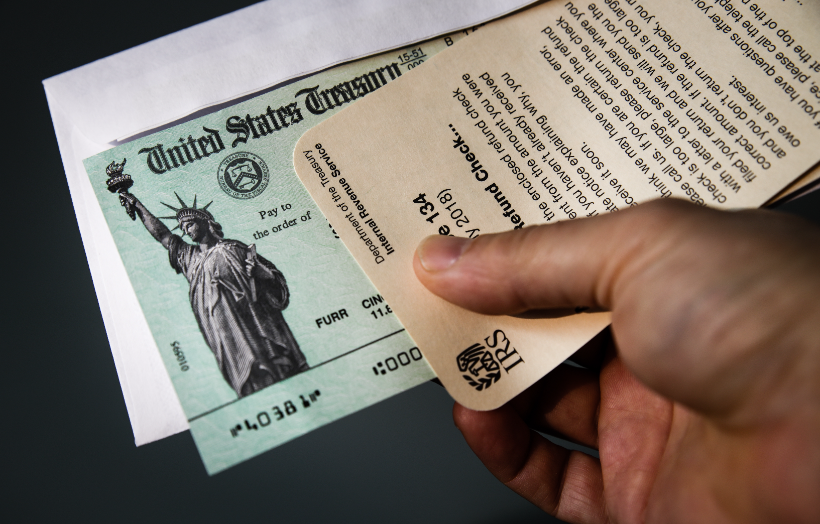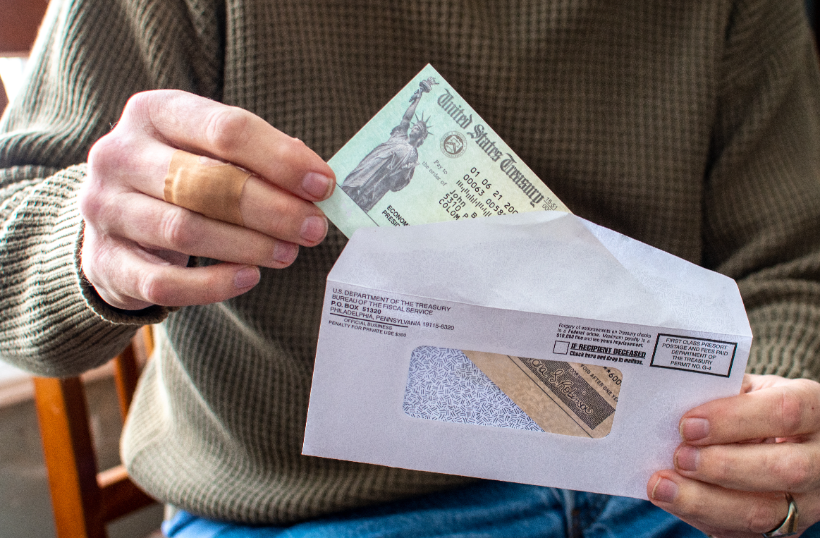
Remember when the government mailed everyone money? Good times.
The Economic Impact Payment 2, also known as EIP 2, was a second round of stimulus cash provided by the government as part of COVID-19 relief efforts. Also called the recovery rebate credit on your income tax return, it aimed to help individual and joint filers cope with the financial challenges caused by the pandemic.
If you received EIP 2, it meant that you satisfied certain eligibility criteria. These criteria included being a U.S. citizen or resident alien, having a valid Social Security number, and not being claimed as a dependent on someone else’s tax return. Single filers with an adjusted gross income of up to $75,000 and married couples filing jointly with an adjusted gross income of up to $150,000 were eligible for the full amount. The amount of money you received through EIP 2 depended on your filing status and income level. Single filers could receive up to $600, while married couples filing jointly could receive up to $1,200. Even better, taxpayers with kids got $600 more for each child.
There were a few payment timing questions that came up regularly, and an online payment tool certain taxpayers who didn’t use direct deposit payments to get their recovery rebate credit. But overall, the purpose of EIP 2 was to provide financial assistance to individuals and families who were facing economic hardship due to the COVID-19 pandemic. It served as a stimulus payment aimed at boosting the economy and providing relief during these challenging times.
You may want to save the official payment letter as a piece of important history.
The Story of the Economic Impact Payments and COVID-19 Stimulus
As the COVID-19 pandemic impacted the world, governments worldwide implemented various measures to support their citizens. In the United States, one such measure was the Economic Impact Payment (EIP), commonly known as the stimulus payment. Essentially, you received a tax credit before you submitted your federal income tax return for the next year. These provisional payments showed up on your individual or joint returns as the recovery rebate credit. The EIP aimed to provide financial relief to individuals and families facing economic hardships during these challenging times. In response to the ongoing crisis, the government introduced the second round of stimulus cash called Economic Impact Payment 2, or EIP 2. This additional payment sought to extend aid and support to eligible taxpayers in their recovery efforts.
The recovery rebate credit/EIP program played a crucial role in alleviating financial stress and stimulating economic growth during the pandemic. It felt like getting a tax refund every month in paper checks or direct deposit payments.
Who Qualified for EIP 1, EIP 2 and EIP 3?
To determine who qualifies for the Economic Impact Payments (EIPs), it is essential to understand the eligibility criteria for each round of payments. EIP 1, which was authorized under the CARES Act, provided direct financial assistance to eligible individuals and families.
For EIP 1, you could qualify if you were a U.S. citizen, permanent resident, or qualifying resident alien with a valid Social Security Number (SSN). Additionally, if you were a single filer, your adjusted gross income (AGI) had to be below $75,000. For married couples filing jointly, the threshold was $150,000. If you were a head of household filer, the AGI limit was $112,500.
EIP 2, also known as the COVID-related Tax Relief Act payment, used similar eligibility criteria to EIP 1. However, this time, nonresident aliens, those without a valid SSN, and those claimed as a dependent on another taxpayer’s return were excluded.
EIP 3, authorized under the American Rescue Plan Act, expanded the eligibility criteria to include individuals with an Individual Taxpayer Identification Number (ITIN), as well as U.S. citizens and resident aliens with valid SSNs. Similar income limits were applied as in EIP 1 and EIP 2. Those with an individual taxpayer identification number are generally the foreign residents working and earning money in America but not immigrating (and don’t have a social security number to put on their federal income tax return.)
How much money did an individual get?
How much money did you get from each round of Economic Impact Payments (EIPs)? Let’s break it down for you.
In EIP 1, eligible individual taxpayers could receive a maximum amount of $1,200. Married couples filing jointly could receive up to $2,400, and qualifying child dependents added an additional $500 to the payment.
Moving on to EIP 2, eligible individuals received a slightly smaller amount of $600. For married couples filing jointly, the maximum payment was $1,200. Child dependents once again added an additional $600 to the payment.
Finally, EIP 3 increased the payment amount to a maximum of $1,400 for eligible individuals. Married couples filing jointly could receive up to $2,800, and child dependents added an additional $1,400 to the payment.
It’s important to note that these maximum amounts were subject to a phase-out at higher income levels. The payments gradually decreased for individuals with adjusted gross incomes (AGI) above certain thresholds.
So, depending on which round of EIP you were eligible for and your individual circumstances, you could have received a maximum amount of $1,200, $600, or $1,400, along with additional payments for child dependents.
(Please note: This information is based on the past rounds of EIPs. For the most up-to-date information on any future payments, please refer to official sources.)
EIP 4: Will there be more stimulus cash?
As of the time of writing, there is no official confirmation regarding a potential EIP 4 or whether there will be more stimulus cash in the future. The information provided here is based on the available details up to EIP 3.
The eligibility and amount of the stimulus payments were determined by various factors. Eligible taxpayers included single filers, married couples filing jointly, and individuals who filed as head of household. The type of form used for filing (such as tax returns or the agency’s non-filers tool) and residency status (resident or nonresident alien) also played a role in determining eligibility.
The stimulus payments were part of different relief packages, including the CARES Act, the Consolidated Appropriations Act, and the COVID-Related Tax Relief Act. Each package offered different amounts for the stimulus payments, with EIP 1 providing a maximum of $1,200, EIP 2 offering $600, and EIP 3 increasing the payment to a maximum of $1,400.
The payments were subject to income thresholds. Individuals with adjusted gross incomes (AGI) above certain limits experienced a phaseout, resulting in decreased payment amounts. The specific income thresholds varied depending on filing status, with married couples filing jointly having a higher threshold compared to single filers or head of household filers.
Please note that the information about EIP 4 and any further stimulus cash is subject to change. It is important to stay updated with official announcements and guidelines from relevant authorities.
How Was EIP 2 Different? Advance Payments, Direct Deposit, More
How was EIP 2 different? Well, EIP 2, or the second round of Economic Impact Payments, brought some changes compared to the previous stimulus payments. Here’s what you need to know:
- Advance Payments: EIP 2 introduced the concept of advance payments. Instead of waiting to claim the credit on your tax return, eligible individuals received their payments in advance based on their 2019 tax return information.
- Direct Deposit: Like the first round, EIP 2 continued to offer direct deposit as a fast and convenient option. If the IRS had your bank account information from your previous tax return or you provided it through the IRS’s “Get My Payment” tool, the payment was directly deposited into your account.
- Amount: EIP 2 provided a payment amount of $600 per eligible individual, half the amount of the first round. However, there was an additional $600 per child payment for eligible taxpayers with qualifying dependents.
These changes in EIP 2 aimed to provide faster relief to those in need during these challenging times. If you were eligible for the payment and had direct deposit set up, you likely received your EIP 2 without any delays.
What Did You Have to Do to Qualify for EIP 2?
To qualify for EIP 2, you had to meet certain eligibility criteria. This included being a U.S. citizen, a permanent resident, or a qualifying resident alien. Of course, you also needed a valid Social Security number (SSN).
It was important to note that you couldn’t be claimed as a dependent on another taxpayer’s return. Nonresident aliens and deceased taxpayers were also excluded from receiving EIP 2 payments.
One update with EIP 2 was regarding partial payments for married couples filing jointly. If one spouse had a valid SSN and the other spouse didn’t, the spouse with the valid SSN could still receive a payment of $600. However, if both spouses didn’t have valid SSNs, they wouldn’t qualify for the payment.
Overall, the eligibility criteria for EIP 2 were designed to ensure that only eligible individuals received the stimulus payments. By meeting these criteria, you were able to receive the much-needed financial support during these challenging times.
“The Check’s in the Mail!” How Did You Get EIP 2?
If you were eligible for EIP 2, there were various methods through which you could have received your payment. The most common way was through direct deposit. If the IRS had your bank account information from a previous tax return or if you provided it through the “Get My Payment” tool, your payment would have been deposited directly into your account. This method ensured faster access to the funds.
Alternatively, some recipients received their EIP 2 payments through a paper check. If you didn’t have your bank account information on file with the IRS or if there was an issue with the direct deposit, a paper check was mailed to your registered address. Although it took longer to receive your payment through this method, it still ensured you got the financial assistance you were entitled to.
For a select group of individuals, the government introduced a new payment method called the Economic Impact Payment Card. This card functioned like a debit card and was loaded with the EIP 2 funds. It was sent to eligible taxpayers who didn’t provide their bank account information to the IRS, allowing for a convenient and secure way to access their payment.
It’s important to note that EIP 2 payments were subject to certain eligibility criteria. You had to meet the income requirements, file a valid federal tax return, and not be claimed as a dependent on another taxpayer’s return. Additionally, nonresident aliens and deceased taxpayers were excluded from receiving these payments.
Whatever the form of payment, either direct deposit, a paper check or the Economic Impact Payment debit card, the goal of the recovery rebate credit was to ensure eligible individuals received the much-needed financial support they deserved. For those unaccustomed to seeing a federal agency issue payments, the recovery rebate credit helped with mortgage payments, private student loan payments, and more. Clamoring for extra rounds of stimulus payments did lead to a second chapter in the recovery rebate credit.

Jacob Dayan
Entrepreneur • CEO Community Tax, LLC
Jacob Dayan is the CEO and co-founder of Community Tax LLC, a leading tax resolution company known for its exceptional customer service and industry recognition. With a Bachelor’s degree in Business Administration from the University of Michigan’s Ross School of Business, Jacob began his career as a financial analyst and trader at Bear Stearns and Millennium Partners before transitioning to entrepreneurship. Since 2010, he has led Community Tax, assembling a team of skilled attorneys, CPAs, and enrolled agents to assist individuals and businesses with tax resolution, preparation, bookkeeping, and accounting. A licensed attorney in Illinois and Magna Cum Laude graduate of Mitchell Hamline School of Law, Jacob is dedicated to helping clients navigate complex financial and legal challenges.






